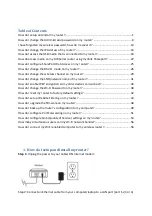
BelAir100SN User Guide
Using Layer 2 Tunnels
May 31, 2010
Confidential
Document Number BDTM11001-A01 Released
The TEP strips off the encapsulation data to reveal the original Ethernet frame
exactly as sent by the AP. The TEP delivers the Ethernet frame to a
VLAN-aware Ethernet switch. The switch applies normal Ethernet forwarding
rules to send it to a gateway router with one router port per subnet. The
gateway router switches the Ethernet frame to the appropriate outgoing router
port.
For packets moving in the other direction to the wireless client, the gateway
router applies to IP traffic an Ethernet header with the client’s MAC address as
the destination. The VLAN switch forwards this packet to the interface on
which it last saw the client’s MAC address, which is the interface connected to
the tunnel. The TEP receives the frame and encapsulates it in an IP packet.
When the AP receives the packet, it strips off the encapsulation data, converts
the resulting Ethernet frame to an 802.11frame, and then transmits it to the
wireless client.
When a mobile wireless client moves to a new AP, its traffic travels through a
different Layer 2 tunnel. The traffic is encapsulated and sent to TEP as before.
The VLAN-aware Ethernet switch then updates its MAC address table as
required with the information for the wireless client’s new AP. Any subsequent
frames sent to the wireless client are then forwarded to the new AP.
Tunneling is performed by a software module called a
tunnel engine
. BelAir
platforms can have only one tunnel engine. Each tunnel engine can create up to
five tunnels to one or more TEPs. The end points of a Layer 2 tunnel are
identified by their IP addresses. The IP address of the BelAir tunnel end point
can be the IP address of the unit’s management interface, or any IP address
associated with a VLAN. The BelAir IP addresses can be set manually or
through the Dynamic Host Configuration Protocol (DHCP).
Each tunnel can carry traffic belonging to any group of configured VLANs.
By assigning a group name to tunnels, you can also use BelView NMS to do
dynamic load balancing of APs between different LNSs.
Configuring the
BelAir Node for
Layer 2 Tunneling
The following tasks can be done:
•
“Displaying Tunnel Configuration and Status” on page 152
•
“Starting and Stopping Layer 2 Tunneling” on page 153
•
“Configuring Layer 2 Tunnels” on page 153
•
















































